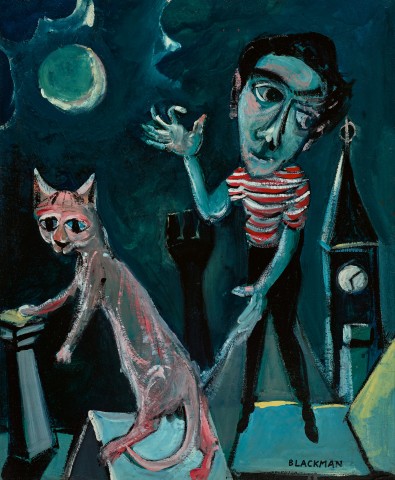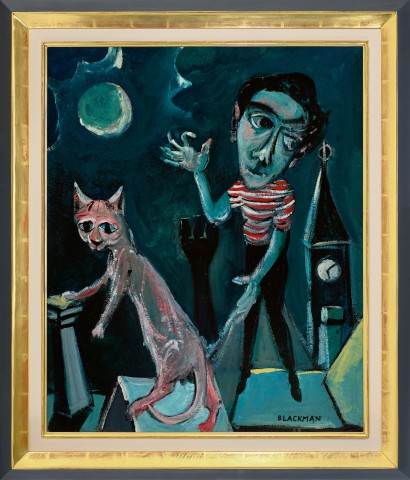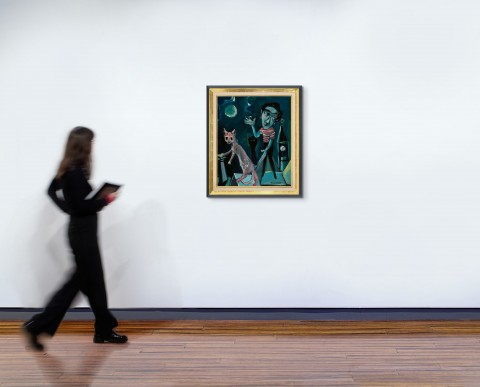SELF PORTRAIT WITH CAT ON ROOFTOPS, c.1952
CHARLES BLACKMAN
enamel on cardboard
76.0 x 51.0 cm
signed lower right: BLACKMAN
bears inscription on backing verso: CHARLES BLACKMAN
Private collection, Melbourne, a gift from the artist, early 1950s
Walter Granek Fine Art, Melbourne
Private collection, Melbourne, acquired from the above in 2001
Possibly: private exhibition at the artist’s Hawthorn studio, February 1952
‘Hand in hand, young and brash, eager and confident, Charles Blackman and I – two bits of string tied in a knot – came to Melbourne in January 1951.’ 1 So begins a key chapter in Barbara Blackman’s memoir Glass After Glass: Autobiographical Reflections, and follows the newlyweds as they navigate the city, advertising at one stage for a ‘coach house, loft, garage, sleepout or shed for use as an artist’s studio.’2 They eventually found the perfect place, behind a mansion in Hawthorn. Around the corner was the framing business run by the Smith family, including son Gray, who was married to Joy Hester. Shaded by a huge Moreton Bay fig, with the top half of the stable door of the coach house latched open as a window, Blackman began to paint furiously in enamel on cardboard and unprimed sheets of Masonite, often on both sides, and soon mounted an exhibition there in which Self Portrait with Cat on Rooftops, c.1952 was a likely inclusion.
There is a wonderful photo of Blackman surrounded by these early cat paintings, which peer over his shoulder as he reclines whilst playing with a kitten. Identifiable works include the large Cat On the Roof, a smaller self-portrait, and at the back, one of a number of portraits of Barbara, Girl and Cat; all are close relatives of Self Portrait with Cat on Rooftops. The cat was the artist’s ‘first emergent, identified Blackman-type image,’ 3 preceding the famed ‘Schoolgirls’ series from the following year; indeed, some works from late 1952 combine both motifs. Blackman’s peripatetic childhood included stints in Sydney’s Redfern, Manly, and Kings Cross, where he fondly remembered feeding stray alley cats. Blackman had worked as a copy artist from the age of fifteen at the Sydney Sun before travelling to Brisbane where he met the poet Barbara Patterson, the future Mrs Blackman, and her friend, the artist Laurence Hope. Travelling then to Melbourne, he was introduced by the poet Barrie Reed to John and Sunday Reed who quickly recognised his talent. Sunday, whose own menagerie of cats was extensive, delighted Blackman by giving him a copy of Collette’s Creatures Great and Small.4 The couple bought at least four paintings from the coach-house exhibition and would eventually own twenty-nine works across a range of media.
Through the Reeds, Blackman encountered Nolan’s ‘Kelly’, ‘Wimmera’ and ‘St Kilda’ series which both inspired and challenged him, and he would also soon be taken under the wing of the flamboyant Danila Vassilieff. All of these stimuli can be detected in Self Portrait with Cat on Rooftops, where the artist and his feline doppelgänger dance upon the buildings under the gaze of the moon and the clocktower of nearby Hawthorn Town Hall. The image is immediate and whimsical, but also displays the artist’s nascent talent, particularly with the confidence of the brush work and in small accents such as the blaze of yellow contrasting the blue at bottom right. Whilst the cat casts an inquisitive glance at the viewer, Blackman averts his own eyes, hinting at a restless inner world.
1. Blackman, B., Glass After Glass: Autobiographical Reflections, Penguin, Melbourne, 1997, p. 139
2. Ibid., p.141
3. Charles Blackman, 1979. Interview with James Gleeson, quoted in: Morgan, K (ed.), Charles Blackman: schoolgirls, Heide Museum of Modern Art, Melbourne, 2017, p. 30
4. See: St John Moore, F., Charles Blackman: Schoolgirls and Angels, National Gallery of Victoria, Melbourne, 1993, p. 33
ANDREW GAYNOR


